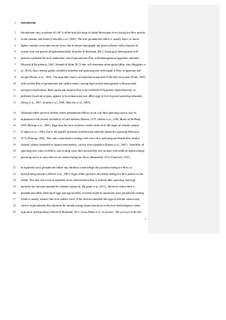| dc.contributor.author | Casas-Mulet, Roser | |
| dc.contributor.author | Alfredsen, Knut | |
| dc.contributor.author | Brabrand, Åge | |
| dc.contributor.author | Saltveit, Svein Jakob | |
| dc.date.accessioned | 2018-01-29T12:57:03Z | |
| dc.date.available | 2018-01-29T12:57:03Z | |
| dc.date.created | 2014-09-29T18:21:50Z | |
| dc.date.issued | 2015 | |
| dc.identifier.citation | Hydrobiologia. 2015, 743 (1), 269-284. | nb_NO |
| dc.identifier.issn | 0018-8158 | |
| dc.identifier.uri | http://hdl.handle.net/11250/2480294 | |
| dc.description.abstract | Groundwater may create refuges for Atlantic salmon egg survival during low flows in regulated rivers and thus play an important role for survival during winter. To investigate the links between the survival of salmon embryos and hyporheic hydrological processes during permanent winter drawdown, a 100-m-long and 50-m-wide gravel area in a regulated river, the River Suldalslågen, was used for an experimental study. Surface and subsurface water levels were monitored with 2-min time resolution by means of water pressure sensors placed in pipes. Temperature, conductivity and dissolved oxygen were also measured. Eight cylindrical boxes, each with two compartments (at 10- and 30-cm depth, respectively) containing 50 Atlantic salmon eggs, were placed in the river bed substrate of both the drawdown zone and the permanently wetted area as a reference. They were regularly checked for survival during winter from January to May, coinciding with egg development period for this river. Survival rates in boxes in the dewatered river bed were between 8 and 78% during winter, compared to 80 to 99% in the reference wetted area. The main driver for egg survival in the dewatered area was groundwater with sufficient oxygen levels. | nb_NO |
| dc.language.iso | eng | nb_NO |
| dc.publisher | Springer Verlag | nb_NO |
| dc.title | Survival of eggs of Atlantic salmon (Salmo salar) in a drawdown zone of a regulated river influenced by groundwater | nb_NO |
| dc.type | Journal article | nb_NO |
| dc.type | Peer reviewed | nb_NO |
| dc.description.version | acceptedVersion | nb_NO |
| dc.source.pagenumber | 269-284 | nb_NO |
| dc.source.volume | 743 | nb_NO |
| dc.source.journal | Hydrobiologia | nb_NO |
| dc.source.issue | 1 | nb_NO |
| dc.identifier.doi | 10.1007/s10750-014-2043-x | |
| dc.identifier.cristin | 1159569 | |
| dc.relation.project | Norges forskningsråd: 193818 | nb_NO |
| dc.description.localcode | This is a post-peer-review, pre-copyedit version of an article published in [Hydrobiologia]. The final authenticated version is available online at: https://link.springer.com/article/10.1007%2Fs10750-014-2043-x | nb_NO |
| cristin.unitcode | 194,64,91,0 | |
| cristin.unitname | Institutt for bygg- og miljøteknikk | |
| cristin.ispublished | true | |
| cristin.fulltext | postprint | |
| cristin.qualitycode | 1 | |
